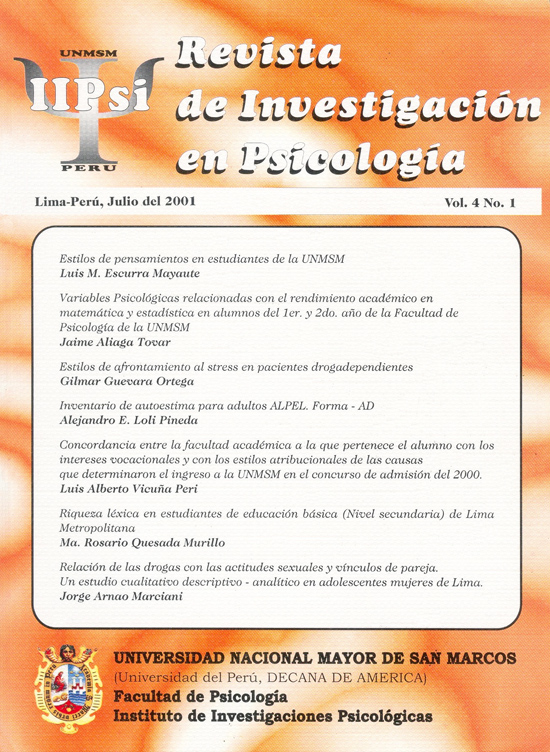Relationship between drugs with sexual attitudes and the relations of a couple, a qualitative descriptive -analytic study with teenager girls from Lima
DOI:
https://doi.org/10.15381/rinvp.v4i1.5014Keywords:
adolescents, alcohol, drugs, sexuality, relations of a couple, recreationAbstract
This study uses a qualitative, descriptive analytic methodology, and interprets the significant factors of sexual risk for adolescents of Lima, who meet for recreation in a context where there exists both alcohol and drugs. The work is composed of 64 adolescent women between the ages of 15 and 18. The criterion for selection is based on unidentified informants. The focus was eight groups in a pre-university academy in the center of Lima. The first incident of intoxication was found to be around 15 years. The situations are the following: the end of high school (planned meetings), the promotional party, the fifteen-year birthday party, and miscellaneous walks. The friends are constituted by a social group where the offer and/or the availability for the consumption of marihuana is given for the first time. The paste base of cocaine (PBC) is the drug least associated with adolescents, where its consumption is related to negative attitudes and its definite rejection, contrasted with ecstasy, which is continually growing in more popular sectors such as C and D, and shrinking in sectors A and B, where it had initially appeared. There exist two points of view concerning virginity: the first affirms that it must be kept and continued, and the other places its relevance in the personal decisions of a relationship. However; those of the first position do not know if they will continue their virginity in the future. The most feared consequence of having sexual relations for these adolescents is becoming pregnant, and after that is the fear of HIV. It should be called to attention that the majority of the adolescents interviewed have suffered some type of sexual aggression. Furthermore, it is found that there exists three basic different types of sexual behaviour among the young in a context of recreation, known in English roughly as one, superficial physical contact, two, "hooking-up, "and three, "going-out."Downloads
Published
Issue
Section
License
Copyright (c) 2001 Jorge Arnao Marciani, Carlos Cabezudo Moreno

This work is licensed under a Creative Commons Attribution-NonCommercial-ShareAlike 4.0 International License.
THE AUTHORS RETAIN THEIR RIGHTS:
a. The authors retain their trademark and patent rights, and also on any process or procedure described in the article.
b. The authors retain the right to share, copy, distribute, execute and publicly communicate the article published in the Journal of Research in Psychology (for example, place it in an institutional repository or publish it in a book), with acknowledgment of its initial publication in the Journal of Research in Psychology.
c. Authors retain the right to make a subsequent publication of their work, to use the article or any part of it (for example: a compilation of their work, lecture notes, thesis, or for a book), provided that they indicate the source. of publication (authors of the work, magazine, volume, number and date).






